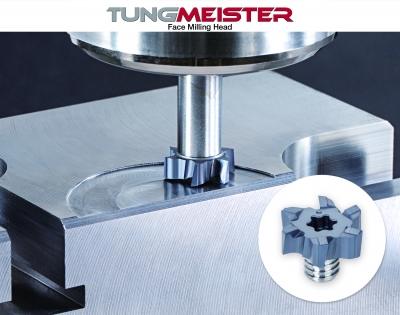Contact Details

Tungaloy has introduced a new VFM style milling head to the popular TungMeister series of exchangeable-head end mill systems to enable face milling operations.
TungMeister is designed to reduce a significant amount of tool changeover time through the ability to replace used heads instead of an entire tool. Since it takes no more than one minute for tool exchange, setup time can significantly be reduced to as short as one tenth of the time it would typically take to replace solid carbide end mills for maximum productivity and cost effectiveness. With over 13,000 possible head-shank combinations available, TungMeister can readily provide tooling flexibility that enables users to find a solution for almost every application.
Using a solid carbide end mill to do face milling on small workpieces is often inefficient; its pointed bottom edges with no wiper create an uneven, often unacceptable, surface finish. An indexable face mill is, in many cases, too large to fit in the tight area of the small workpiece. In addition, the number of teeth on the face mill is usually less compared with the end mill of the same size, restricting the use of higher feeds and speeds for improved machining efficiency.
The new VFM end milling heads will address this challenge. The cutter diameter of all VFM heads are designed to be larger than standard end milling heads of the same connector size; a standard TungMeister square end milling head with S05 connection has a cutting diameter of 8.0 mm (.315″), while the new VFM cutting diameter comes in 12 mm (.472″). This feature enables the use of relatively large-diameter face milling tools on small Swiss machines. In addition, a wiper built in every cutting edge of the VFM head provides superior finish.
Related Glossary Terms
- gang cutting ( milling)
gang cutting ( milling)
Machining with several cutters mounted on a single arbor, generally for simultaneous cutting.
- milling
milling
Machining operation in which metal or other material is removed by applying power to a rotating cutter. In vertical milling, the cutting tool is mounted vertically on the spindle. In horizontal milling, the cutting tool is mounted horizontally, either directly on the spindle or on an arbor. Horizontal milling is further broken down into conventional milling, where the cutter rotates opposite the direction of feed, or “up” into the workpiece; and climb milling, where the cutter rotates in the direction of feed, or “down” into the workpiece. Milling operations include plane or surface milling, endmilling, facemilling, angle milling, form milling and profiling.
- milling machine ( mill)
milling machine ( mill)
Runs endmills and arbor-mounted milling cutters. Features include a head with a spindle that drives the cutters; a column, knee and table that provide motion in the three Cartesian axes; and a base that supports the components and houses the cutting-fluid pump and reservoir. The work is mounted on the table and fed into the rotating cutter or endmill to accomplish the milling steps; vertical milling machines also feed endmills into the work by means of a spindle-mounted quill. Models range from small manual machines to big bed-type and duplex mills. All take one of three basic forms: vertical, horizontal or convertible horizontal/vertical. Vertical machines may be knee-type (the table is mounted on a knee that can be elevated) or bed-type (the table is securely supported and only moves horizontally). In general, horizontal machines are bigger and more powerful, while vertical machines are lighter but more versatile and easier to set up and operate.
- wiper
wiper
Metal-removing edge on the face of a cutter that travels in a plane perpendicular to the axis. It is the edge that sweeps the machined surface. The flat should be as wide as the feed per revolution of the cutter. This allows any given insert to wipe the entire workpiece surface and impart a fine surface finish at a high feed rate.





